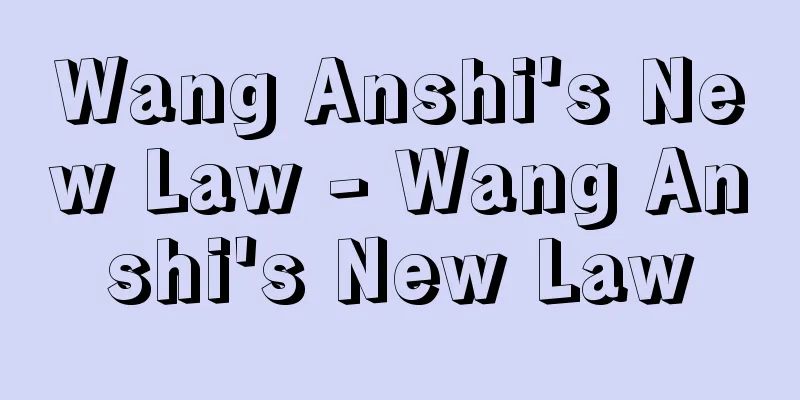Wang Anshi's New Law - Wang Anshi's New Law

|
Innovative policies implemented by Wang Anshi during the reign of Emperor Shenzong (reigned 1067-85) of the Song Dynasty in China. The Equal Transportation Law notified the Yangzhou Shipping Office of the type and amount of goods the government needed each year, and had them procured from areas that produced them in large quantities. Instead of demanding goods that the people did not produce, they had them pay for goods that they produced in large quantities. When these goods were no longer needed, they were transported to areas that needed them and sold. This was an attempt to eliminate middleman exploitation by merchants and streamline the government's consumer economy. The Green Seed Law was a law that provided low-interest loans to farmers who lacked seed rice and other supplies before planting, and required them to repay the principal and interest at harvest time, in an attempt to relieve farmers from oppression by landlords. The Market and Equal Tax Law was a law that provided low-interest loans to merchants. The Square Field Equal Tax Law was a law that conducted land surveys based on 1,000 steps (square fields) on each side of the rice fields, and made the amount of tax fair. The Service Law (Service Law) was a reform of the method of paying official duties. The Hoko Law designated 10 families as 1 Ho, 5 Ho as Daiho, and 10 Daiho as Toho, and appointed Hocho, Daihocho, and Tohosho to oversee police affairs and provide martial arts training every year during the farming off-season. The Houma Law required Hoko applicants to keep horses, and in return, they were exempted from paying labor. Other laws include the Kura Law, Tejitsu Law, and Sansha Law. Source: Encyclopaedia Britannica Concise Encyclopedia About Encyclopaedia Britannica Concise Encyclopedia Information |
|
中国,宋の第6代神宗皇帝 (在位 1067~85) のとき,王安石が行なった革新的な諸政策。均輸法は年間の政府必要物資の種類と量とを揚州の発運司に通知し,多量に産する地方で調達させ,人民には産しない物を要求せず,多く産する物を代納させ,これが不要のときは必要とする地方に運んで売却するもので,商人の中間搾取を排し,政府の消費経済を合理化しようとしたもの。青苗法は植付け前に種籾などの欠乏する農民に低利で融資し,収穫時に元利を返済させる法で,地主の圧迫から農民を救済しようとしたもの。市易法は商人に対する低利融資法。方田均税法は,田の東西南北各 1000歩 (方田) を基準として検地を行い,租税額を公平にする法。募役法 (役法) は職役の負担方法の改革。保甲法は,10家を1保,5保を大保,10大保を都保とし,保長,大保長,都保正をおき,警察のことを司らせ,毎年農閑期に武事を教習させる法。保馬法は保甲の希望者に馬を養わせる法で,代償として賦役を免じた。このほか倉法,手実法,三舎法などがある。
出典 ブリタニカ国際大百科事典 小項目事典ブリタニカ国際大百科事典 小項目事典について 情報 |
<<: The Great Law of Oan - Oan no Taiho
Recommend
Complete unemployment - Complete unemployment
...the population that has the will and ability t...
Court Gardening
…Palace gardens were built in which rare exotic f...
One-way flow - Katanagare
A type of roof shape in which the slope flows down...
Salted rice - Shiotemai
This was rice lent to salt producers by the Kanaza...
Zhōng guó huà (English spelling) Zhongguohua
…Chinese people usually call Chinese language Zhō...
Kahoku [town] - Kahoku
An old town in the middle reaches of the Monobe Ri...
Mr. Inada - Inadauji
A samurai family in the early modern period. The c...
Girl Guide
…the movement was founded in the UK in 1910 by Ba...
Via Cassia (English spelling)
...There are many branch roads. (8) Via Cassia: A...
Darkroom Photo Mirror - Anshitsushashinki
...At first, it was used literally as it sounds, ...
Alceides - It's because
…Eurydice, who became the wife of Orpheus, and Da...
Ahem - Ahem
...The alcohol content is around 4% (by volume). ...
Karinto - Karinto
〘 noun 〙 A type of confectionery. Wheat flour is s...
Roar - roar (English spelling) beat
The phenomenon in which the amplitude of the compo...
Sabbath year - Ansoku-nen
…It was already included in the fourth of the Ten...









